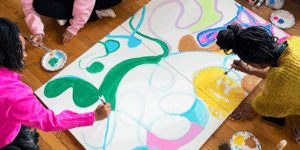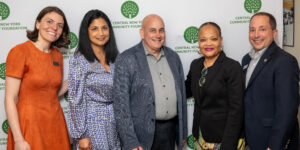Reflections: Our Personal & Professional Efforts Toward Racial Equity is a monthly blog. Each month, a member of our staff will reflect on what they are doing either personally or professionally to improve diversity, equity and inclusion in our work. View more
As a staff, we want the Community Foundation to be a welcoming place for donors and those seeking funding. And we strive to be purposeful in our efforts to cultivate that welcoming environment. Philanthropy in our country has traditionally been viewed through the lens of wealth, and the racial wealth gap in America is well documented. We also know that generosity is not limited to one particular racial or ethnic group. As part of our continual learning and evolution, we are in the process of setting goals to become better at engaging people who more accurately reflect our whole community, not just those who have historically been associated with philanthropy.
In order to keep us accountable to these objectives and measure our progress, we need to know more about the demographics of our constituents – the donors, volunteers and potential donors with whom we interact – and then gather that information in our records. We have not previously tracked statistics on individuals’ racial or ethnic background, nor have we asked for it. But it will be hard to see if we’re improving if we don’t know where we’re starting from, which means finding a way to discover and record this data is crucial.
The challenge around this endeavor is ensuring that people are not reduced to data points, but rather that the statistics we capture are being used for purposes that align with our organization’s mission.
Part of my work in philanthropic services is overseeing the database that houses information about the people and organizations that engage with the Community Foundation. We take the security and confidentiality of our data very seriously, and do not share it with outside groups.
One of the things I’ve come to realize during our staff’s journey to learn about and counteract racial injustice and inequity is just how hurtful labels can be. And that grouping people without forethought, especially when they’re not allowed a voice in that process, can be destructive.
So before we even began collecting data I looked to my colleagues who were instrumental in building and facilitating our Black Equity & Excellence Fund for their thoughts on what words we should use when describing racial and ethnic identity. We asked our board members, we referenced the U.S. Census and consulted other community foundation peers as well.
Answering questions about racial or ethnic background isn’t easy or straightforward for everyone. And because individuals are often treated differently due to how they identify themselves (or how others classify them) not everyone is comfortable sharing that information, especially if they’re unsure how it will be used.
So we chose to invite people to share this information about themselves, rather than requiring it or making assumptions about their racial or ethnic background. And we articulate why we are asking for it and how it will strengthen our attempts to become a better, more equitable organization.
Below is the question we added to the intake form we ask new fundholders and new board members to complete. The question is optional:
At the Community Foundation, we strive to build relationships with people of diverse backgrounds within our community. To help us measure our efforts and progress, please consider indicating which you identify with most (you may choose more than one):
☐ Black/African American
☐ Asian American/Pacific Islander
☐ Latino/Latina
☐ Native American/Indigenous
☐ White
And we offer additional space, in case someone would like to share beyond what fits in a checkbox:
If you would like to offer additional detail on your racial/ethnic background, please do so.
We hope this is a respectful way to gather the information we’re looking for, and balances honoring individuals with building the data set we need for metrics. As with many of the processes we use, it is open to change as we learn more and evolve more toward the organization we seek to become.









